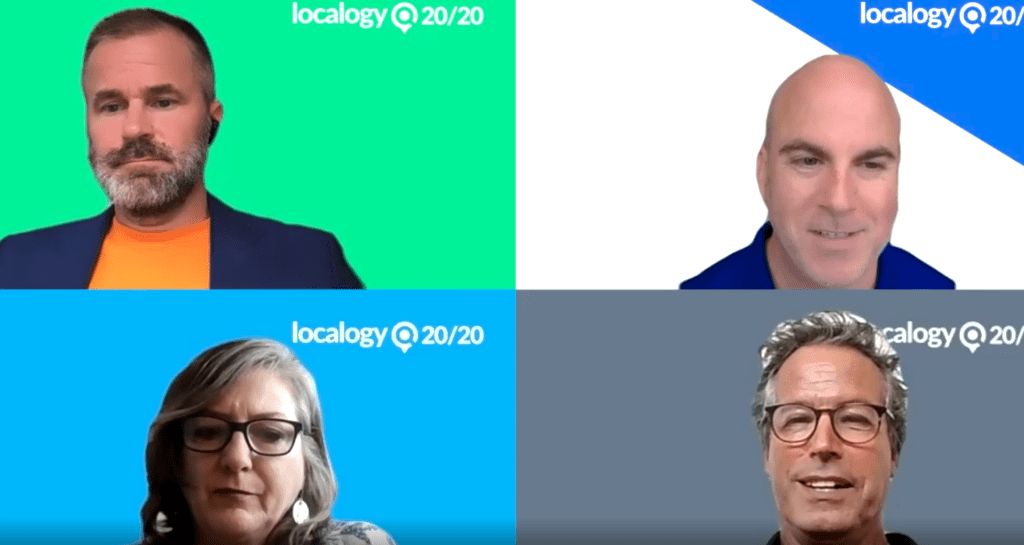We had two sessions on Day 1 of Localogy 20/20 that took a hard look at how the pandemic has forced a real reckoning and injection of creativity into how we think about commercial space.
We kicked off the day with a conversation about cities and how we can restructure them to avoid what moderator Dan Hight called “the broken window syndrome.”
Later in the morning, another panel addressed how retail is being reshaped by the pandemic. A common thread ran right through both conversations. How to re-imagine the use of commercial space to avoid blight. And more importantly, how to use this moment to imagine something new and better in our urban commercial zones.
Opportunity for Renewal
Our three panelists, Nathan Elliot, Jack Iles, and Genevieve Morrel, all spend their days imagining ways to keep cities fresh and vibrant. All three agreed that, however painful, the current crisis also presents opportunities.
“The world stopped, it paused,” Nathan said. “And it forced us to look at the future.” Similar to how a forest fire leads to new growth (maybe not the best metaphor this week), Nathan said the pandemic has a similar impact on cities. Pain, followed by renewal.
Jack and Genevieve cited a number of alternative uses they are seeing pop up in commercial centers that could change the nature of spaces in mostly positive ways.
“This is really an opportunity for some fresh thinking,” Jack said. He cited brand activation and pod sharing (an alternative living model) as two immediate uses for retail space impacted by COVID.
Both he and Genevieve cited medical facilities as a new alternative use for both office and retail space. And more arts and cultural uses are coming into space once devoted to retail or other commercial uses.
“We need the arts and culture more than ever before,” Genevieve said.
Removing Barriers
Another area the panelists cited for an overdue rethink involved regulation and zoning. There seemed to be a clear consensus that a crisis is not the best time to strictly enforce zoning rules, for example. And better yet, it’s a great opportunity to re-assess things like parking requirements that are based on a development model from the 1940s.
Red tape that burdens small businesses in normal times is crushing during a pandemic. Jack pointed out that opening a restaurant in Los Angeles requires contact with 25 different agencies. And even though fitness is in great demand in Hollywood, a street-level gym requires a zoning variance.
The panelists expressed their hope that the pandemic will compel local governments to get their acts together.
But it’s not just government. Jack cited another barrier that has quietly suppressed local businesses over the years — the notion of the “credit tenant.” That is the favoritism that property owners gave to chain stores over local brands, which they factored into the value of the asset. That thinking will need to change to keep spaces vibrant. The credit tenants may not be flocking back when the crisis subsides.
The economics of local space has fundamentally changed. And again, not necessarily because of COVID. But the crisis has sped things along. One example Genevieve cited is venue space on Hollywood Boulevard. The larger venues are disappearing and they won’t return. A more likely future involves intimate performance spaces inside other venues like hotels.
“There are economic forces that cannot be denied,” Jack said.
Silver Linings
Some good will come from the crisis. In addition to the general opportunity for renewal that we’ve discussed. The main one being a dramatic reduction in rents, which could spur renewal and reshaping of city spaces.
“There will not be the hollowing out of New York City that people are predicting,” Jack said. “But there will be an opportunity for cities to recast themselves. Artists, creative startups may be able to afford what they’ve been priced out of.”
Nathan said the reduction in rents “will open up streetscapes to digitally native brands.”
But despite believing in the pandemic’s accelerating impact on the transformation of cities, there was a general sense that cities are more reslient than given credit right now. Nathan cited a recent article by Jerry Seinfeld that said, in essence, “You can’t add remote everything to everything.”
Cities Undergoing Transformation
Cities were already in a state of transformation, from Smart Cities to revitalization of neglected areas. What impact has COVID-19 had on the urbanization, redevelopment, and how people live in cities and the acceleration of Smart Cities?
Speakers:
Nathan Elliott, Frontrunner Technologies
Jack Illes, Hollywood Redevelopment Group
Genevieve Morrill, West Hollywood Chamber of Commerce





